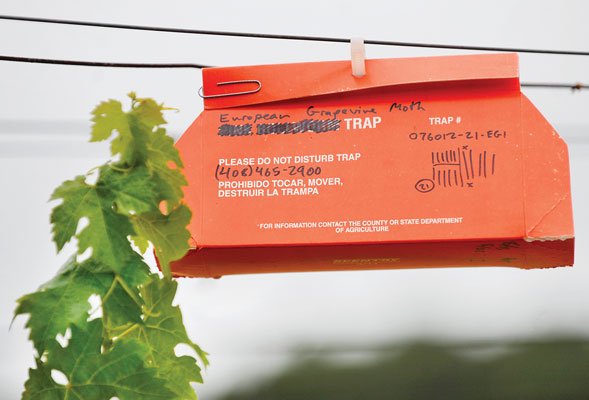In what winemaker Dan Martin called
”
the most labor-intensive year that we’ve had,
”
Gilroy viticulturists grappled with powdery mildew, unseasonably
cool temperatures, the ominous threat of an elusive European
grapevine moth and a prolific population of happy-go-lucky ground
squirrels.
In what winemaker Dan Martin called “the most labor-intensive year that we’ve had,” Gilroy viticulturists grappled with powdery mildew, unseasonably cool temperatures, the ominous threat of an elusive European grapevine moth and a prolific population of happy-go-lucky ground squirrels.
Candidly put, a year marked by 24.10 inches of rain in Gilroy – coupled with the coolest summer climate in 40 years – “sucks,” said Martin, who, along with his wife, Therese, operates Martin Ranch Winery on Redwood Retreat Road.
In terms of labor and expenses, Martin notes “we’ve been growing grapes since ’93, and last year was the most difficult year we had until this year. This year is worse.”
But the squirrels are loving the weather, apparently.
“Tim has had ground squirrels reproducing across the street, and I keep complaining to him that he keeps sending them over to me,” joked Mike Vanni, co-owner of Solis Winery.
Vanni’s 16-acre property on Hecker Pass Highway sits diagonal from Sarah’s Vineyard, owned by Tim Slater.
Mike’s brother and Solis co-owner, Vic Vanni, echoes his fellow oenophiles. It’s been a cool summer, thus a “very slow” ripening process, he said. Fourth-generation winemaker Gino Fortino, who runs Fortino Winery several minutes West on Hecker Pass, agrees: “It’s been too cold. Things are just taking forever to ripen.”
Not only is it unusual to have two identical summers back-to-back (in 2010, Gilroy had 24.85 inches of rain) Vic recalls temperatures rarely peaked above 100 degrees. Whereas June, July and August are traditionally hot and dry, he said local vineyards were haunted by a lurking fog bank hovering over Mt. Madonna “probably about 75 percent” of the summer.
“I go back 30 years, and you don’t see summers like this too often,” he said.
Despite variables in growing conditions, Garlic Capital grape gurus revere weather curveballs as an occupational hazard. Unlike their strawberry and cherry cultivating counterparts – some who suffered six-figure losses after consecutive showers – area viticulturists say this years’ harvest could yield some downright delicious vino.
That is, if Mother Nature doesn’t rain on their parade last minute.
With harvest time around the corner, growers say a random drizzle is fine – but consecutive days of precipitation is an unwanted wild card.
“We just don’t know yet,” said Martin, on pinpointing the outcome of this years’ yield. “If we do not get early rains, this could be a wonderful year. What makes a good year is how long the grapes hang on the vine.”
At least one upside can be extracted from experiencing two identical seasons.
“Last year, I learned a lot about how to deal with this year, ” said Vanni, dropping fruit with a pair of clippers as he meandered down a row of 5-year-old cabernet sauvignon vines.
Mike explained modest temperatures and plenty of precipitation can lead to excess fruit, necessitating extra diligence when it comes to achieving a uniform flavor profile. This entails snipping off premature grapes, ensuring underdeveloped fruit isn’t picked and thrown into the mix alongside ripe fruit. Mike says this methodical tactic enhances the richness, complexity and fullness of taste.
Ideally, the Vanni brothers say days in the high 80s to low 90s with cool nights are ideal growing conditions. The best thing, Mike says, is just a nice, gradual ripening.
“And that’s why this region does so well – because we have that coastal influence that keeps our nights cool,” he explained. “It extends our growing season because our grapes aren’t ripening overnight.”
The Martins also encountered a larger crop yield due to excess water, which generated a spike in labor expenses for crop thinning and fruit dropping.
“This year, there was lots of groundwater and no heat to evaporate it,” explained Martin. “So the plants just continued to grow. That’s been a major problem.”
On the heels of more water and milder climates comes powdery mildew – a white, splotchy fungus that thrives in temperatures between 60 and 80 degrees. Martin says this threat in Gilroy “has been 100 percent in the last few months.”
Like Sarah’s Vineyard, the Martins are anticipating a late harvest. For them, it could be somewhere near the end of October or early November.
“We’re not even getting out the harvest equipment yet,” said Martin. “We’re all anxious.”
Ten minutes north on Watsonville Road at Clos LaChance Winery, 1 Hummingbird Lane in San Martin, yields in general are down 30 percent. Sauvignon Blanc alone is down 40 percent, according to head winemaker Jason Robideaux. He said LaChance is two to three weeks behind “what we compare against average.”
Like his fellow oenophiles, Robideaux has his fingers crossed that the season finishes out with little to no rain, and comfortable temperatures in the mid to high 80s.
Still, “every year is gonna be different,” he points out, optimistically. “It’s just something you have to adapt to.”
Over at Sarah’s Vineyard, Slater said brisk weather hasn’t been too debilitating. His Pinot Noir and white varietals tend to ripen fairly early, he said.
The rodents, on the other hand, are another story.
“The gophers and groundhogs have just gone nuts this year,” he said. “They’re everywhere. It bugs the hell out of me.”
For at least the five wineries contacted, one pest appears to have been kept under wraps.
When larvae of the invasive, crop-destroying European grapevine moth were first discovered in Napa County in 2009, the quarantine eventually expanded in September 2010 to South County after three third-generation adult moths were found near Watsonville Road. The moth feeds on ripening grapes, exposing the fruit to fungal infections.
Jason-Stephens Winery at 11775 Watsonville Road and Solis Winery were at the epicenter of discovery. Those at-risk included 10 to 20 residential growers within 400 meters of the infestation according to Kevin O’Day, the Santa Clara County’s acting agriculture commissioner. In September, workers from the Department of Agriculture installed traps around South County called “delimitation trapping,” which helps determine how large the infestation might be. Each one of the 39 growers in the 619 acre quarantined area was outfitted with one to two orange traps, which are coated in a sticky lining, scented with pheromones and checked every two weeks by a government employee. In 2011 so far, O’Day said most of the 19 moths were located in the backyards of small homegrowers.
“We’re no way out of the woods, but we’ve got excellent progress,” he said. “We’ll trap again next summer and see where we’re at. So far, so good.”
Because of the moth, all bulk grapes, harvest bins and equipment must comply with rules for leaving the quarantined area. Martin said these imposed requirements are “relatively simple.” Grape bins need to be covered during transport, and the fruit must be processed within two hours once it reaches the winery.
“But that’s a normal procedure anyway,” he pointed out.
While Solis sits about three miles from where the moths were found, the winery “breezed through” the year without any sightings, Mike said.
“I completely forgot about it. I’ve talked to trappers and they haven’t seen anything,” he said. “It’s not that big of a threat right now, as far as I’ve heard.”
Like Solis, the owners of Sarah’s, Clos LaChance, Fortino and Martin winery have no sightings to report. Calls placed to Jason-Stephens Winery, Kirigin Cellars and Hecker Pass Winery were not returned as of press time.
Scant moth sightings is good news for Gilroy’s wine community, which is blossoming as a tourist magnet according to Jane Howard, executive director of the Gilroy Visitors Bureau.
“Their reputation continues to be significantly improving,” she said. “There’s just more and more buzz about them.”
On the Gilroy Visitors Bureau website, Howard said the winery home page is the first or second most visited link every month.
According to Agriculture Commissioner Kevin O’Day, the gross value of wine grapes harvested in Santa Clara County in 2010 was $7,059,000.
Cruising through Gilroy back roads is more convenient and less expensive than a trip to Napa, said Mike Vanni, who still meets people in Gilroy who have no idea “there’s wineries in their back yard.”
While each winemaker strives to stand out above the rest, he underscores success experienced is success shared. When you’re neighbor is doing great, it’s good for everyone, he said. People don’t taste at one winery – “they taste at several.”
In retrospect, Gino Fortino said he wouldn’t necessarily call this year the most difficult he’s ever encountered.
While cooler temperatures certainly raised production hurdles, “Every year creates its own challenges,” he said. “You just gotta roll with it.”















